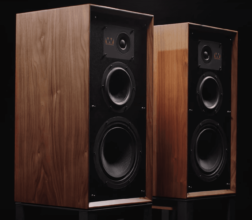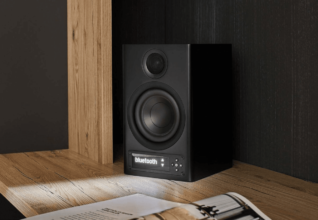Klipsch The Nines Review
The Nines are two compact yet powerful speakers that stay true to Paul W. Klipsch’s finest stereo traditions. At the same time, they feature the latest technology—from HDMI connections to app-based controls—hinting at the shape of high-end audio for the future.
By Andreas Günther
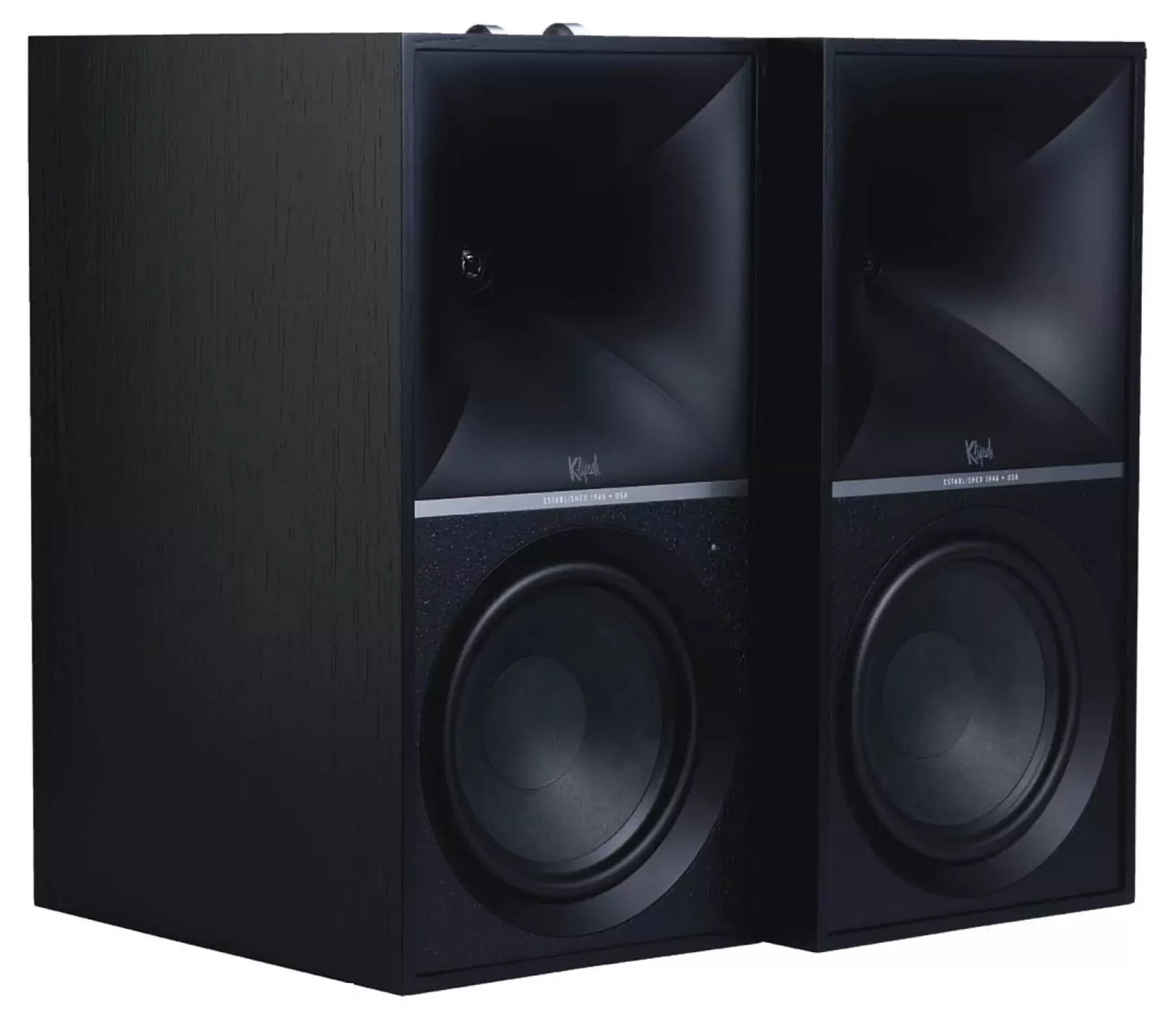
This trend is too strong to be overlooked. While traditional enthusiasts still rely on multiple components, there is a counter-trend toward simpler, more efficient solutions with plenty of power. The problem: these two directions rarely intersect. Anyone attuned to today’s realities should reconsider their lineup—not just by adding small Bluetooth speakers or stylish in-ears.
Classic stereo hallmarks such as turntable connectivity, large drivers, and horns are just as important. Klipsch is in a unique position to bring both worlds together. Since the first Klipschorn in 1946, Paul W. Klipsch had already proven his point. Now, his successors’ horn-loaded stereo speakers are taking a decisive step into the modern era. Three models cater to different requirements for size and power:
The Fives, The Sevens, and The Nines.
We chose the largest set—The Nines—for our listening room. They merge vintage charm and modern engineering in a brilliant way. Officially, Klipsch markets them under the “Heritage” label—a tribute to an ongoing legacy that started decades ago. The walnut finish, in particular, could fool you into thinking these are classic 1950s speakers, much like the continuous production lineage at Klipsch. Yet, on closer inspection, you’ll notice modern touches. There are two knobs on top of one speaker—one for source selection and one for volume—and all amps are built-in. The rear panel brings us into the present day: one speaker is the “master,” and the other is the “slave,” connected by a four-pin cable. The included cable is four meters long but can be extended to six meters, suitable for most listening spaces.
Master and Slave
An important switch on the back of the master speaker decides whether it sits on the left or right. More decisions follow. Klipsch tempts us with multiple options: an analog input plus an RCA pair specifically for turntables. (High-output MM cartridges only, but at least it’s there.) To the right is the digital section for hooking up, say, a CD player or streamer via optical. You can even connect directly via USB from your computer, supporting up to 192/24 resolution. But is this a high-end desk speaker? Not exactly—at almost half a meter tall, they’re not suited for near-field listening. We recommend sitting about 2.5 meters away, or more, for best results.
The icing on the cake is an HDMI-ARC port, opening a whole new world. Imagine a big TV with these two speakers on either side. It looks great, sets up easily via HDMI, and targets everyone who prefers true stereo over a soundbar. For hassle-free music streaming, simply use Bluetooth from your smartphone. In marketing terms, these speakers are like “jack-of-all-trades”—but in the best sense.
Klipsch also offers a powerful companion app. Besides the remote control and the onboard knobs, the app provides even more options. You can tell it where the speakers sit—by a wall, freestanding, or in a corner—and the bass adjusts accordingly. You’ll also find presets like “Rock” or “Vocal.” However, it’s more precise to tweak the EQ for bass, mids, and treble. Most people will use “Dynamic Bass EQ,” which boosts bass at lower volumes. Worried about neighbor relations? Hit “Night Mode” to tone down explosive bass peaks.
A subwoofer output is on the back too, but most users won’t need it. A stereo pair of The Nines delivers plenty of low-end on its own—enough to satisfy most living rooms without going overboard.
These speakers are fully active, driven by powerful digital amplifiers that feed each driver independently. You get a total of 240 watts on tap, so no driver is left underpowered. A 20 cm wood-fiber woofer handles low and mid frequencies, while the tweeter setup is more distinctive: a titanium diaphragm feeds a patented “Tractrix” horn. This round horn gradually transitions to a square opening at the front, controlling the dispersion both vertically and horizontally.
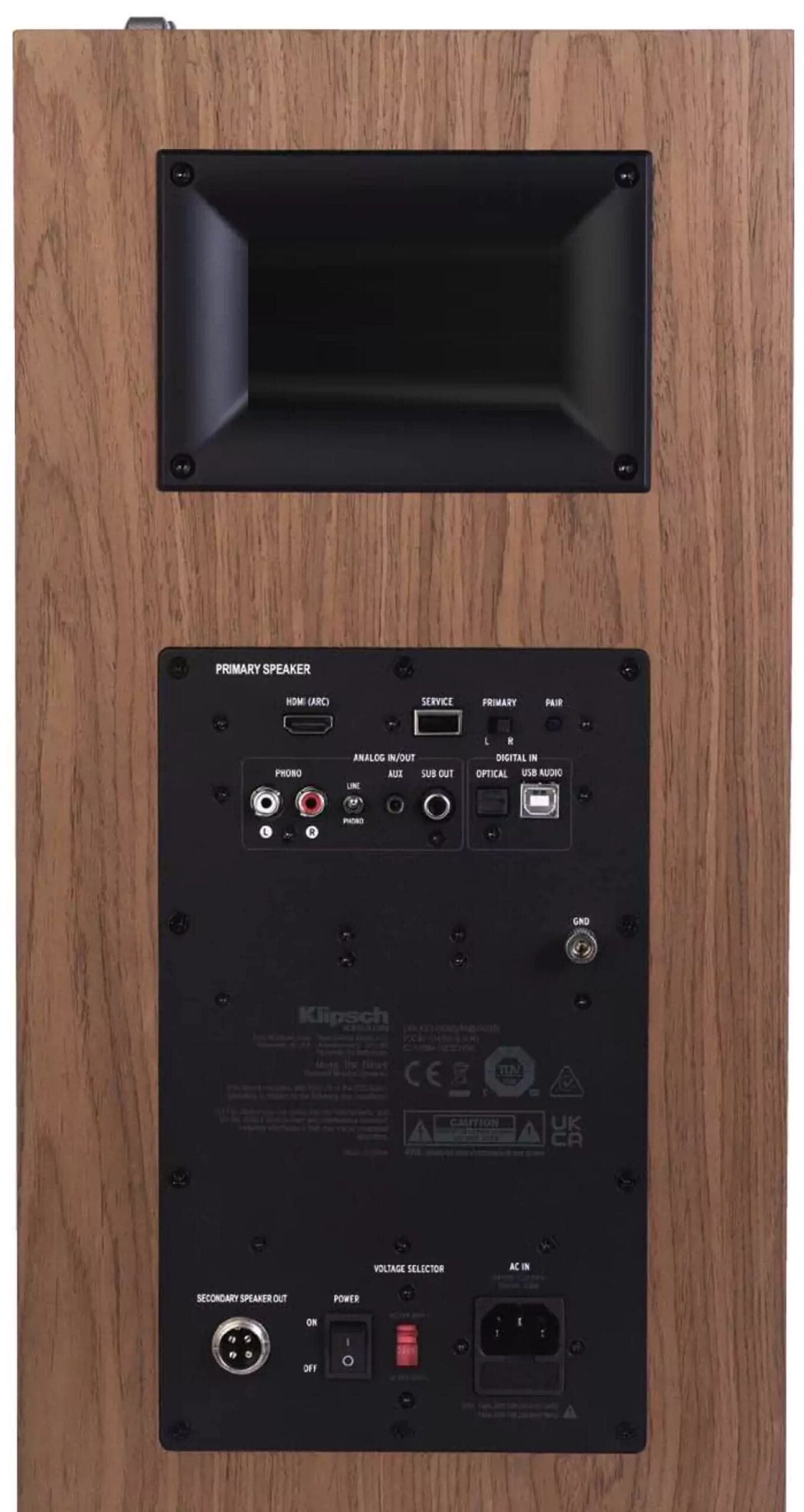
THE MASTER: A switch lets you select whether it goes on the left or the right. Connection options abound.
Lab Measurements
The frequency response is balanced with minimal peaks or dips. Treble rises on-axis and stays linear if the speaker isn’t angled toward the listener (blue curve at 30° off-axis). By default, bass is dialed down about 2 dB, though you can adjust it easily in the app. The -3/-6 dB frequencies relative to mid-level between 0.1 and 4 kHz are at 43/36 Hz. Distortion stays slightly higher in low frequencies (up to around 1 kHz), with a maximum bass level of 99 dBSPL. The step response and waterfall plots confirm clean transients. Power use is 0.4 W in standby and 18 W in normal operation.
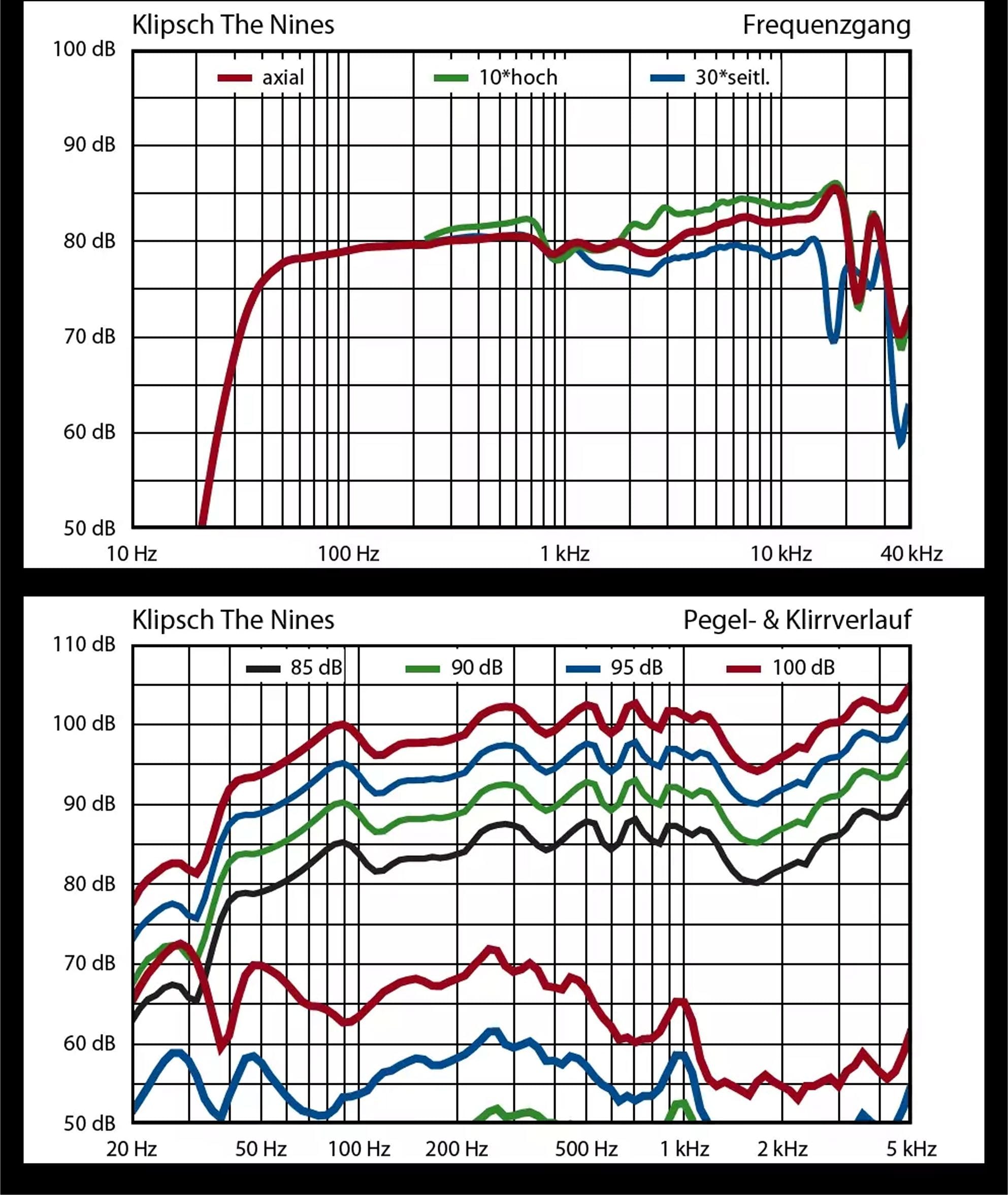

EVERYTHING ON THE TABLE: Klipsch includes all necessary cables, including six meters to link the speakers.
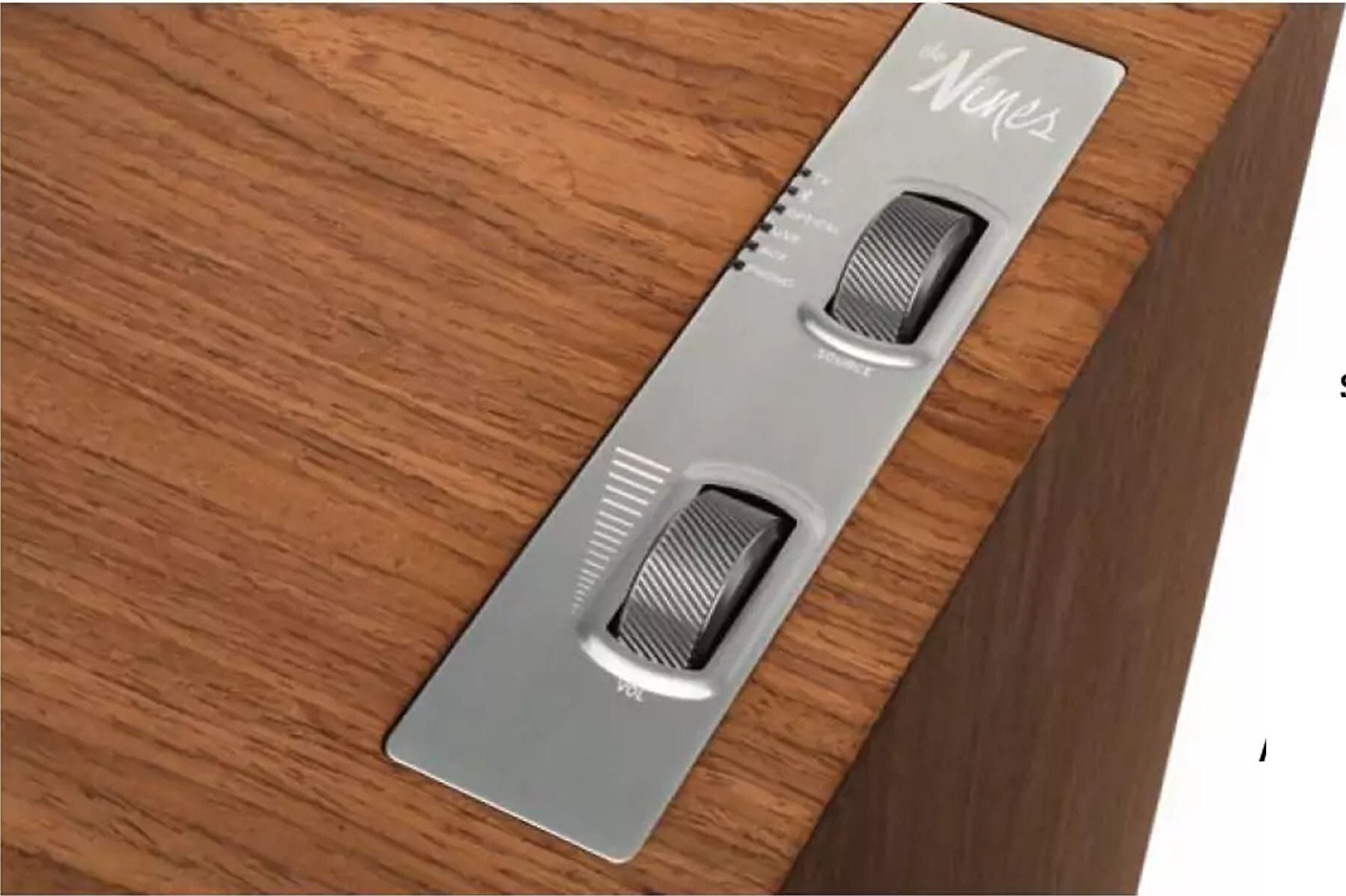
RIGHT ON THE MASTER: Klipsch built a handy control module into The Nines. The top knob selects the source, the bottom knob manages volume. It works seamlessly with the remote and the app.
That’s the core design—a neat trick that pays off. The output is immense; it’s surprising how much impact they deliver to the listening position. Keep in mind that all this energy demands space. Despite their compact look, The Nines are not near-field speakers. We recommend them in rooms over 25 m². They’re not the best fit for a dorm room (that’s where you might prefer The Fives or The Sevens).
This is where they truly shine. Let’s address the price: $2,000 in Germany. That might seem high, but consider that you’re getting a pair of speakers, four power amps, a preamp, a phono stage, a hi-res DAC, and Bluetooth capability. This is a blueprint for the future of high-end audio.
Heavy, Sophisticated Jazz
Blue Note captured Kendrick Scott’s latest album, “Corridors,” which is intricate, harmonically complex jazz—nothing straightforward. Speakers need agility here, and The Nines deliver. Every drum, every cymbal, and every driver in the mix stands out, building a precise soundstage. The “old,” somewhat heavy bass emphasis typically associated with Klipsch is gone. Instead, The Nines offer a vibrant, detailed sound that stays smooth when it matters. Think elegance with the right amount of punch, blending musical energy with analytical clarity. Listening distance seems unimportant—they perform admirably wherever you place them. They’re perfect for anyone who wants a robust living-room setup without bulky monoblocks and massive racks.
Specs
Warranty: 2 years
Finish: Veneer / Foil / Lacquer
Colors: Black Ash, Walnut
Operating Principle: Two-way, bass-reflex, active
Room Adaptation: Via app
Special Features: D/A converter, phono
| PRODUCT | Klipsch The Nines |
| ORIGIN | USA/China |
| TYPE | Powered loudspeaker |
| WEIGHT | Primary: 12.88kg Secondary: 12.25kg |
| DIMENSIONS (WxHxD) | 241×486 x340mm |
| FEATURES | 25mm titanium Tractrix horn tweeter; 203mm long-throw mid/bass driver; Quoted system amplification: 240W |
| DISTRIBUTOR | Henley Audio Ltd. |
| WEBSITE | klipsch.com henleyaudio.co.uk |
Conclusion
Klipsch has nailed this “new ideal.” On the outside, The Nines reflect Klipsch’s signature style. Yet inside, you’ll find a modern engineering marvel—compact, quick, and playful digital amplifiers alongside legendary Klipsch drivers. Clever architecture does away with hefty hardware. The result is an outstanding sound experience, filled with musicality, dynamic presence, and a grand soundstage.
Audiogram
Powerful yet controlled, leaning toward a slim and velvety sound.
- Neutrality (2×): 9/10
- Detail Resolution (2×): 9.5/10
- Localization: 9/10
- Spatial Imaging: 8/10
- Fine Dynamics: 9/10
- Maximum SPL: 9/10
- Bass Quality: 9/10
- Bass Depth: 9/10
- Workmanship: Very good
AUDIO Sound Rating: 90 points (Outstanding)
Price/Performance: Outstanding
When you purchase through links on our site, I may earn an affiliate commission. Here’s how it works.
Klipsch The Nines Review | Best Powered Speaker Yet?
Since Klipsch introduced The Fives in 2020, many other brands have jumped on the bandwagon, modernizing powered speakers ...
Klipsch The Nines vs. The Sevens | Answering to Andrew Robinson
When I saw Andrew Robinson's review of Klipsch's The Nines and The Sevens powered speakers and he suggested The Sevens ...









